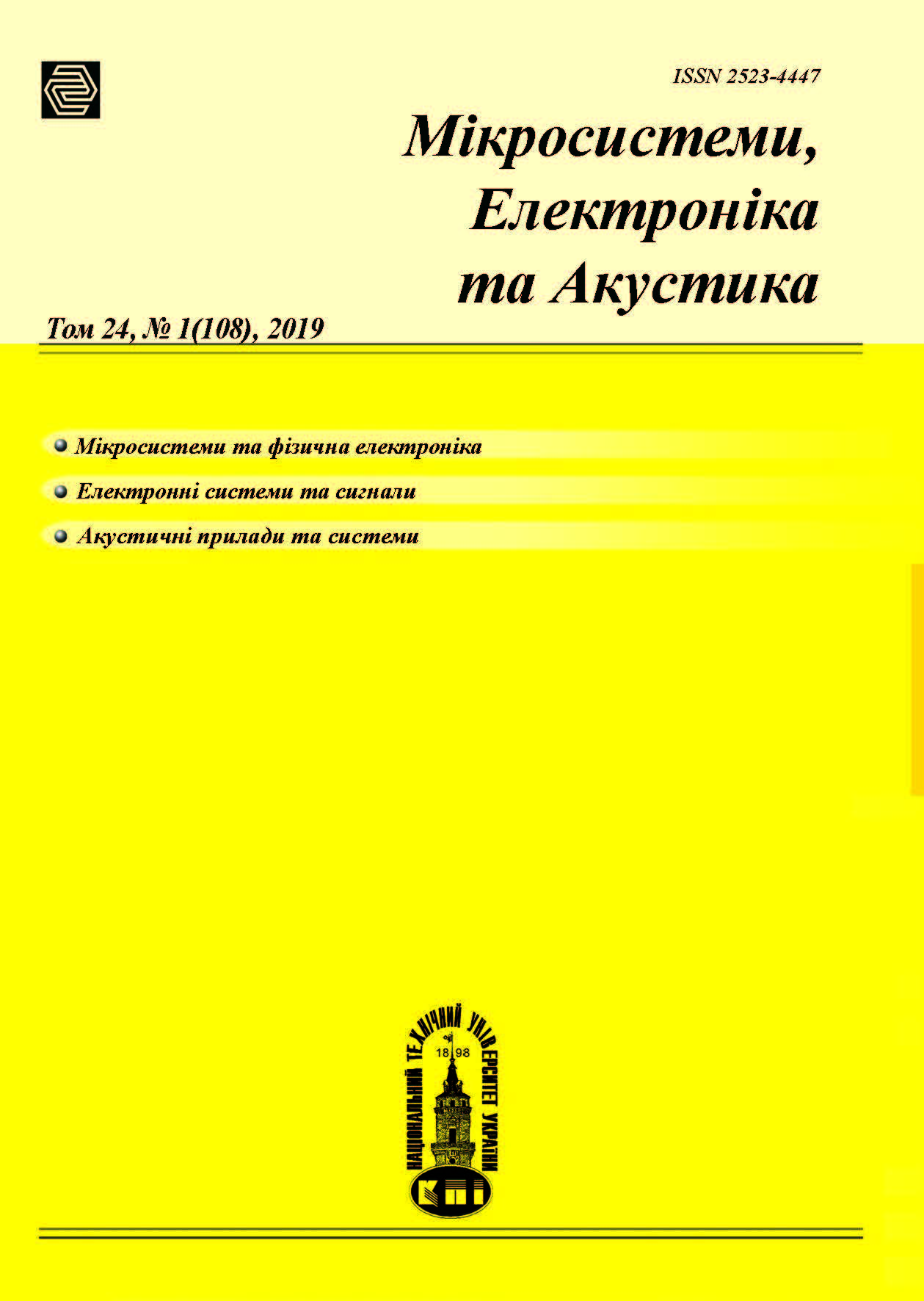Вдосконалення алгоритму обробки даних системи діагностування стану кристалізатора машини безперервного лиття заготовок
Основний зміст сторінки статті
Анотація
З метою підвищення точності діагностування несправних станів механізму хитання кристалізатора машини безперервного лиття заготовок вдосконалено алгоритм обробки даних з MEMS-акселерометрів, що забезпечує зменшення похибок вимірювання параметрів руху кристалізатора за наявності шумів у вихідних сигналах сенсорів. Здійснено імітаційне моделювання роботи запропонованого алгоритму, отримано діаграми, що ілюструють процес вимірювання параметрів руху кристалізатора та підтверджують ефективність запропонованого рішення.
Бібл. 15, рис. 4.
Блок інформації про статтю

Ця робота ліцензується відповідно до Creative Commons Attribution 4.0 International License.
Автори, які публікуються у цьому журналі, погоджуються з наступними умовами:- Автори залишають за собою право на авторство своєї роботи та передають журналу право першої публікації цієї роботи на умовах ліцензії Creative Commons Attribution License, котра дозволяє іншим особам вільно розповсюджувати опубліковану роботу з обов'язковим посиланням на авторів оригінальної роботи та першу публікацію роботи у цьому журналі.
- Автори мають право укладати самостійні додаткові угоди щодо неексклюзивного розповсюдження роботи у тому вигляді, в якому вона була опублікована цим журналом (наприклад, розміщувати роботу в електронному сховищі установи або публікувати у складі монографії), за умови збереження посилання на першу публікацію роботи у цьому журналі.
- Політика журналу дозволяє і заохочує розміщення авторами в мережі Інтернет (наприклад, у сховищах установ або на особистих веб-сайтах) рукопису роботи, як до подання цього рукопису до редакції, так і під час його редакційного опрацювання, оскільки це сприяє виникненню продуктивної наукової дискусії та позитивно позначається на оперативності та динаміці цитування опублікованої роботи (див. The Effect of Open Access).
Посилання
L. Liu, Y. Dun, Y. Fang, and G. Li, “Modeling and verification of the nonlinear system of oscillation platform of continuous casting mold driven by servo motor,” Adv. Mech. Eng., vol. 8, no. 7, pp. 1–9, Jun. 2016. DOI: 10.1177/1687814016656294
A. N. Smirnov, O. V. Antykuz, A. Y. Tsuprun, and V. M. Pil’gaev, “Some approaches to choosing rational mold oscillation parameters,” Russ. Metall., vol. 2008, no. 8, pp. 700–705, Dec. 2008. DOI: 10.1134/S0036029508080119
A. N. Smirnov, S. V. Kuberskii, A. L. Podkorytov, V. E. Ukhin, A. V. Kravchenko, A. Yu. Orobtsev, Nepreryvnaya razlivka sortovoy zagotovki [Continuous casting of billet]. Alchevsk: DonGTU, 2012.
J. Cibulka, R. Krzok, R. Hermann, D. Bocek, J. Cupek, and K. Michalek, “Impact of Oscillation Parameters on Surface Quality of Cast Billets,” Arch. Metall. Mater., vol. 61, no. 1, pp. 283–288, Mar. 2016. URL: http://www.imim.pl/files/archiwum/Vol1_2016/53.pdf
M. Vynnycky, S. Saleem, K. M. Devine, B. J. Florio, S. L. Mitchell, and S. B. G. O’Brien, “On the formation of fold-type oscillation marks in the continuous casting of steel,” R. Soc. Open Sci., vol. 4, no. 6, p. 170062, Jun. 2017. DOI: 10.1098/rsos.170062
“Mould Oscillation Measuring System KS473/KHM,” 2004. [Online]. Available: https://www.mmf.de/pdf/9-1.pdf. [Accessed: 01-Dec-2018].
“OsciMon Exact mold oscillation for perfect casting products,” 2015. [Online]. Available: https://www.primetals.com/fileadmin/user_upload/content/01_portfolio/15_Lifecycle-services/15_2_Diagnostic-systems/OsciMon.pdf. [Accessed: 01-Dec-2018].
“KT400 FieldMOMS Portable Mold Oscillation Monitoring System,” 2019. [Online]. Available: https://www.kisstechnologies.com/wp-content/uploads/2019/03/KT400-ProductSheet-Final.pdf. [Accessed: 01-Apr-2019].
V. A. Didenko, A. F. Bondarenko, A. N. Poleno, “ Obzor sredstv kontrolya trayektorii dvizheniya kristallizatora MNLZ [An overview of the means of controlling the trajectory of the motion of the crystallizer MNLZ],” in Proceedings of the XV International Scientific and Practical Conference "Modern Information and Electronic Technologies (CITI)",” 2014, pp. 58–59.
O. F. Bondarenko and V. O. Didenko, “The system of estimation of the state variables for PWM converter control in the structure of mold oscillation mechanism,” Electron. Commun., vol. 21, no. 5, pp. 14–19, Nov. 2016. DOI: 10.20535/2312-1807.2016.21.5.81934
O. M. Polieno, O. F. Bondarenko, V. O Didenko, “Matematychna modelʹ obrobky danykh v systemi monitorynhu parametriv khytannya krystalizatora mashyny bezperervnoho lyttya zahotovok [Mathematical model of data processing in the system of monitoring the parameters of the rolling machine crystallization machine of continuous casting of billets],” Bulletin of the National Technical University "KhPI" collection of scientific works, thematic issue "New solutions in modern technologies", no. 18(991), pp. 70–76, 2013. URI: http://repository.kpi.kharkov.ua/handle/KhPI-Press/7963
B. Panomruttanarug and R. W. Longman, “The Advantages and Disadvantages of Kalman Filtering in Iterative Learning Control,” Adv. Astronaut. Sci., vol. 130, pp. 347–365, 2008. URL: https://www.researchgate.net/publication/289723787_The_advantages_and_disadvantages_of_kalman_filtering_in_iterative_learning_control
R. Kalman, P, Falb, M. Arbib, Ocherki po matematicheskoy teorii sistem [Essays on the mathematical theory of systems], 2nd ed. Moscow: Editoial URSS, 2004.
D. Simon, “Kalman filtering,” Embed. Syst. Program., vol. 14, no. 6, pp. 72–79, 2001.
N. T. Kuzovkov Modal'noye upravleniye i nablyudayushchiye ustroystva [Modal control and monitoring devices]. Moscow: Mashynostroenie, 1976.





